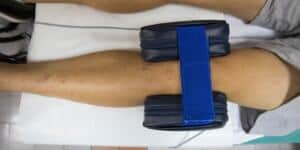If you suspect that you have knee osteoarthritis or are currently experiencing knee pain, please visit this page www.theorthopaedicandpainpractice.com to check if your symptoms match those of knee osteoarthritis.
Do you need knee osteoarthritis treatment, Singapore?
To diagnose knee osteoarthritis, you might want to see an orthopaedic specialist or an interventional pain specialist. They will conduct a number of tests, including a physical exam in which the knee joint will be assessed for flexibility. For example, if you move and the joint emits a cracking or popping sound, this is known as crepitus and could be indicative of knee joint damage.
You may also be asked to take an X-ray so the specialist can confirm if the cartilage between your femur and tibia has eroded or is in the process of erosion, and determine exactly how serious the knee osteoarthritis has become. Do also take note of your medical history, such as when you started to experience your current symptoms of knee osteoarthritis and what activities it restricts you from doing so that the specialist will be able to diagnose your pain with greater accuracy.

So, if I do have knee osteoarthritis, what treatment can I get in Singapore?
Don’t worry! Knee osteoarthritis is not life-threatening if recognised early, and our clinic offers several options for minimally invasive knee osteoarthritis treatment Singapore. In fact, compared to traditional surgeries which require a much longer recovery time and leave surgical scars, our minimally invasive procedures allow you to return to your old lifestyle more quickly. Patients who have already undergone knee replacement surgery but still experience knee pain, or are not making headway with medication and therapy might be inclined to consider these alternative procedures:
Genicular Nerve Ablation
Genicular nerve ablation works by first administering a diagnostic block by injecting a pain-relieving, anti-inflammatory agent around the genicular nerve branches in the knee, as well as using radiofrequency catheters (extremely narrow tubes) to burn off nerve endings that transmit pain from the nerves at the knee joint to the central nervous system (CNS)2 ― you won’t be able to feel the knee pain because it won’t be registered by your brain. A general anesthetic will not be used for this procedure, so you should be able to go home on the same day.
Genicular Artery Embolisation
Genicular artery embolisation also uses catheters, this time inserted through the groin, to block blood flow toward the inflamed parts of the arthritic knee joint. This reduces inflammation in the joint, allowing it to recover. This procedure is low-risk and takes approximately 45 minutes to an hour and a half. You should be able to go home within the day after observation, just like the aforementioned nerve ablation.
Knee Joint Injection
You can also opt for knee joint injections, of which there are different types. The first is a corticosteroid injection, in which pain-relieving steroids are injected into the knee joint. This solution, although it brings instant relief lasting from a few weeks to a month, does not permanently take away the knee pain. Another type is viscosupplementation, which is the injection of hyaluronic acid directly into the knee joint in order to assist the synovial fluid to lubricate the space between the joints further, reducing friction between the two bones. Patients suffering from knee osteoarthritis usually have a lower concentration of hyaluronic acid in their knee joint, so the viscosupplementation aids in bringing it to a normal level5. Similar to corticosteroid injections, it is not permanent. The last type of injection is N-Stride — which uses a patient’s own anti-inflammatory cells obtained from their blood and is re-injected into the knee joint.
What else can I do besides Knee Osteoarthritis Treatment Singapore?
The condition of knee osteoarthritis refers to the erosion of soft cartilage between the femur (thigh bone) and tibia (shin bone), which causes the hard surfaces of the bones to rub against each other, producing painful bone spurs. It also causes inflammation in and around the knee joint. The leading cause of knee osteoarthritis would be the exertion of greater force on the cartilage of the tibia.
For patients who are overweight or obese, attempting to lose weight is recommended6 as it reduces the load stress on your knees. A study showed that the degree of knee pain obese patients with knee osteoarthritis experienced was reduced after they underwent a moderate weight loss regime and lost just over 5% of their body weight over 20 weeks, meaning that they only lost 0.25% of their weight every week7 but felt less pain.
You might also want to consider getting a walking aid as it decreases the load the knees must support as well; if the knee pain only occurs on one leg at one time you could try using a walking stick on the side which does not experience pain, to balance out the weight on both sides of the body.
Hmm, I’m still not too sure, where can I get more information?
You can click on www.theorthopaedicandpainpractice.com/service/knee-pain/ for more information on our procedures, or pay a visit to your usual GP for medical advice. References
- https://nyulangone.org/conditions/osteoarthritis-of-the-knee/diagnosis
- https://www.ncbi.nlm.nih.gov/pmc/articles/PMC6635137/
- https://www.med.unc.edu/radiology/geniculate-artery-embolization-gae/
- https://www.webmd.com/osteoarthritis/corticosteroid-injections-for-osteoarthritis
- https://orthoinfo.aaos.org/en/treatment/viscosupplementation-treatment-for-knee-arthritis/
- http://www.smj.org.sg/article/outpatient-management-knee-osteoarthritis
- https://pubmed.ncbi.nlm.nih.gov/17204567/

